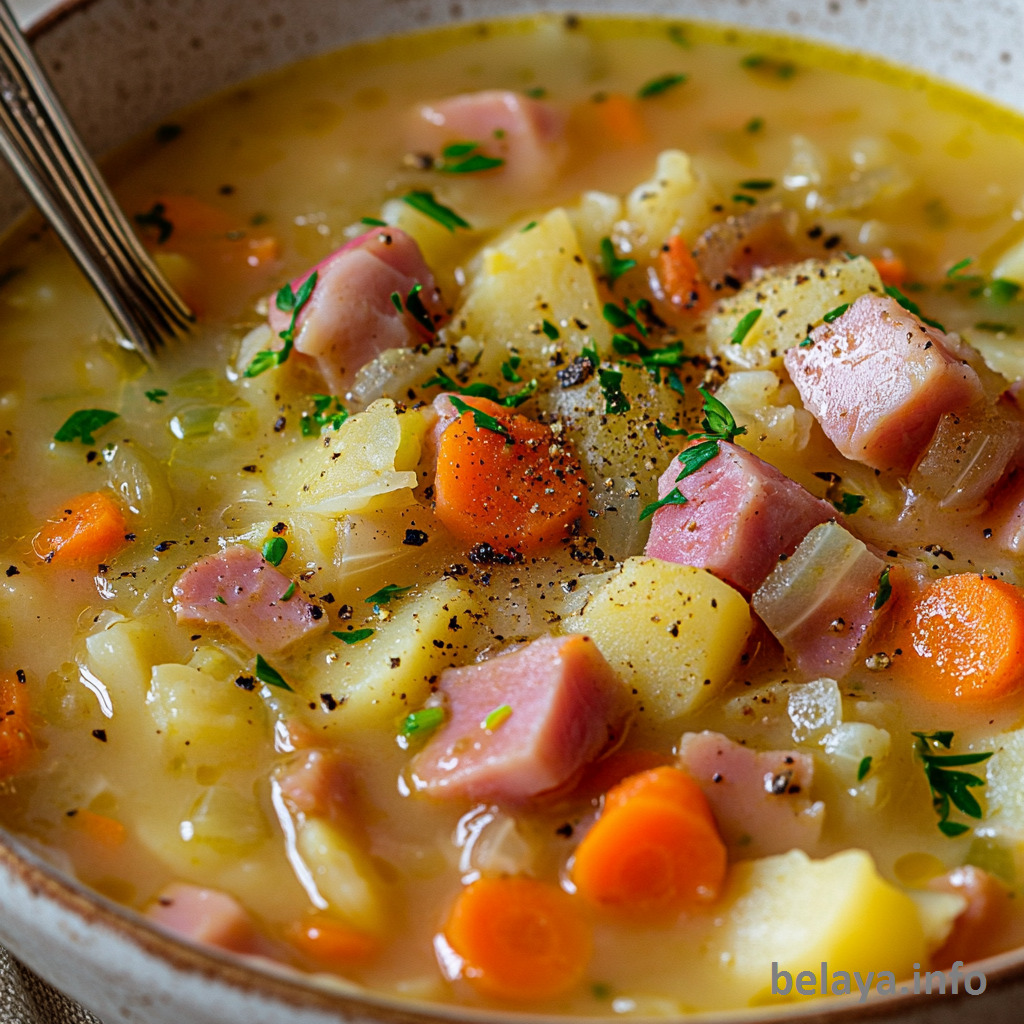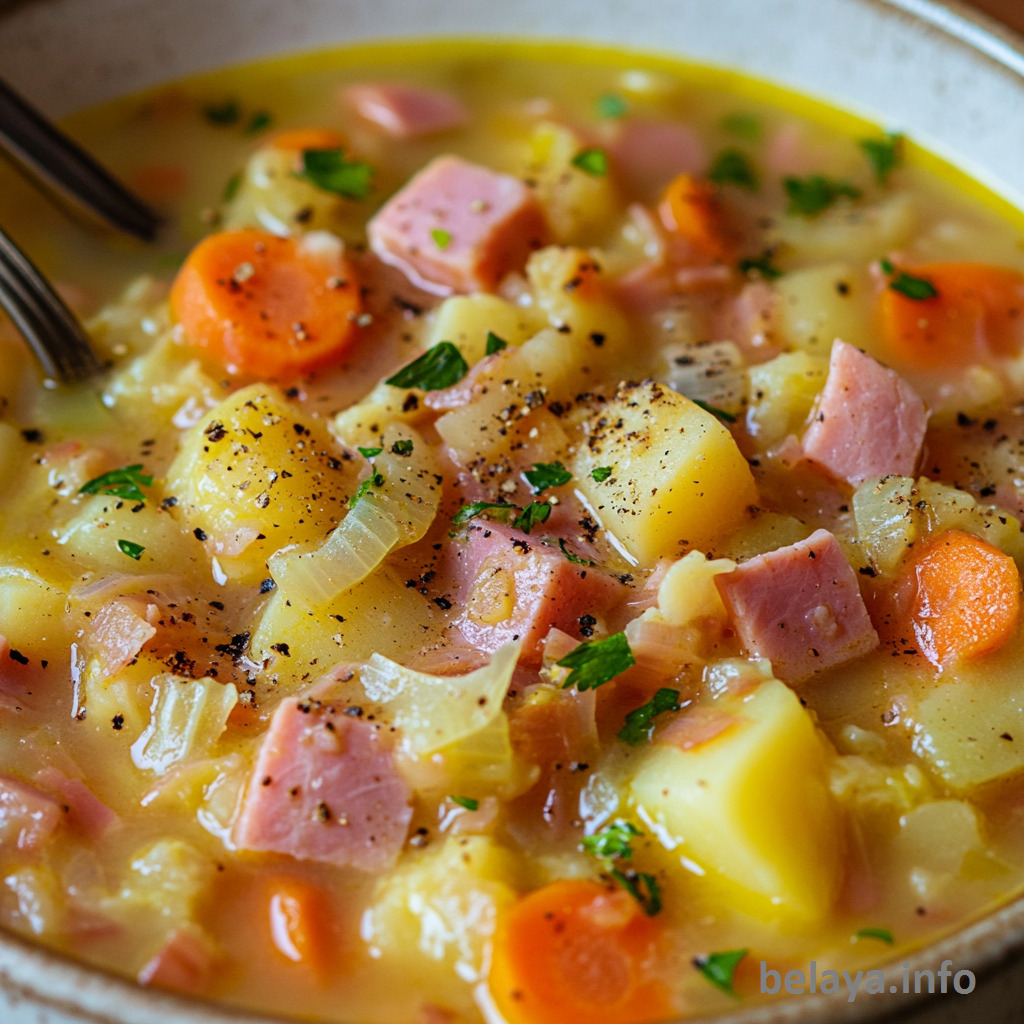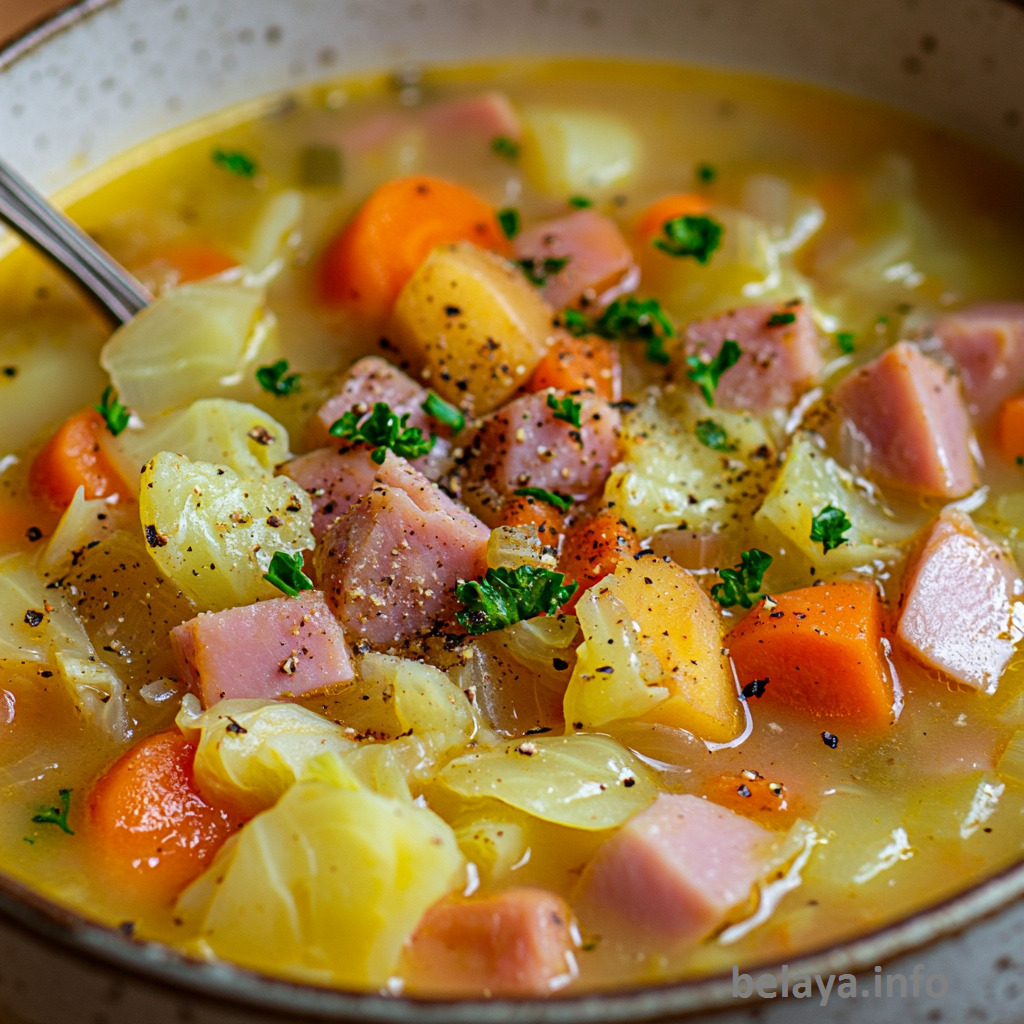Colcannon Soup
Colcannon Soup is a soul-warming twist on a classic Irish comfort food, blending the rustic heartiness of mashed potatoes and cabbage into a rich, creamy bowl of nourishment.
Rooted in tradition yet elevated with the savory depth of bacon, aromatic leeks, and fresh thyme, this soup transforms humble ingredients into something deeply satisfying.
It’s a dish that honors its peasant-food origins while offering a luxurious texture and layered flavor—perfect for cozy evenings, holiday tables, or anytime you crave a taste of simple, honest cooking done right.

Why People Will Love This Colcannon Soup Recipe:
A modern spin on Irish tradition: This soup reimagines the beloved Irish dish “colcannon” in a comforting, spoonable form—offering both nostalgia and novelty in every bite.
Rich, layered flavors from simple ingredients: Smoky bacon, sweet leeks, earthy thyme, and buttery potatoes create a deeply satisfying flavor base that feels both rustic and refined.
Creamy yet nourishing comfort: The combination of tender potatoes, cabbage, and cream yields a velvety texture that’s both hearty and soothing—perfect for cold weather or emotional warmth.
Aromatic depth and complexity: The use of garlic, leeks, and green onions builds a fragrant backbone that balances richness with freshness and gentle sweetness.
Balanced indulgence: While the soup has creamy and savory elements, it’s still grounded in vegetables and broth, making it feel indulgent but not overly heavy.
Visually inviting and texturally rich: The contrast of vibrant greens from the cabbage and scallions with the golden broth and crispy bacon offers both beauty and bite.

Key Ingredients:
Bacon adds more than just savoriness—it builds the soup’s foundation with smoky depth and rich umami. Its rendered fat enhances the vegetables while the crispy bits bring bursts of salty texture.
Leeks and onions offer sweet, aromatic undertones that create the base of flavor. Leeks, in particular, bring a soft, grassy elegance that sets this soup apart from heavier stews.
Potatoes are the heart of the dish—starchy, creamy, and filling. As they simmer, they absorb flavor while also thickening the broth, making the soup naturally rich and hearty.
Cabbage adds traditional Irish authenticity and a rustic earthiness. Its slight bitterness and tender texture perfectly balance the creaminess of the soup.
Chicken broth and heavy cream provide contrast—one offering savory clarity, the other velvety body. Together, they form a harmonious, flavorful base that feels both nourishing and luxurious.
Thyme and garlic elevate the flavor profile with subtle herbal warmth and depth, infusing the soup with comforting complexity.

Expert Tips:
Render bacon slowly for depth of flavor: Start the bacon in a cold pot and cook it over medium heat. This slower rendering process allows the fat to melt gradually, infusing the soup base with a rich, smoky foundation while keeping the bacon crisp.
Clean leeks thoroughly to avoid grit: Leeks often trap dirt between layers. After slicing, soak them in a bowl of cold water and swish well—the grit will sink to the bottom. Lift the leeks out rather than pouring the water off.
Dice potatoes evenly for consistent texture: Cutting the potatoes into uniform bite-sized pieces ensures they cook at the same rate and break down slightly to naturally thicken the soup without turning to mush.
Add cream after the simmer: To avoid curdling and preserve the richness of the heavy cream, stir it in once the soup has finished simmering and slightly cooled. This keeps the texture silky and the dairy stable.
Balance the salt at the end: Bacon and broth can both be salty, so taste the soup after it’s fully assembled and adjust seasoning only as needed. Freshly cracked pepper adds a nice final touch of warmth.
Incorporate the green onions in two stages: Adding the white parts during sautéing builds aromatic depth, while stirring in the green tops at the end introduces a bright, fresh finish that balances the richness.
Let it rest before serving: Like many soups, Colcannon Soup benefits from a short resting period after cooking. This allows the starches and flavors to settle, producing a more cohesive and full-bodied result.

Colcannon Soup
Ingredients
8 ounces of bacon, cut into bite-sized 1-inch pieces
1 medium yellow onion, finely chopped
2 large leeks, cleaned and thinly sliced
2 green onions (scallions), chopped—white and green parts separated
3 cloves of garlic, minced or finely grated
1 teaspoon fresh thyme leaves, finely chopped
6 cups low-sodium chicken broth or stock
½ cup heavy cream or whipping cream
2 pounds of potatoes, peeled and diced into small chunks
4 cups shredded green cabbage
Salt and freshly ground black pepper, to taste
Instructions
Step 1:
In a large soup pot, cook the bacon over medium heat until it becomes crispy.
Once done, transfer the bacon to a plate lined with paper towels.
Keep about 2 tablespoons of the bacon drippings in the pot for added flavor.
Step 2:
Add the chopped onion, leeks, and the white portions of the green onions to the pot.
Sauté for about 5 minutes, or until the vegetables are tender and translucent.
Step 3:
Stir in the garlic and chopped thyme.
Cook for another minute, just until the mixture becomes fragrant.
Step 4:
Pour in the chicken broth and cream, then add the diced potatoes, shredded cabbage, and the reserved bacon.
Bring everything to a boil, then reduce the heat and let it simmer gently for about 10 minutes, or until the potatoes are soft and cooked through.
Step 5:
Taste the soup and adjust with salt and pepper as needed.
Stir in the green tops of the green onions just before serving for a fresh burst of flavor.
Serve hot.

Important Notes When Making Colcannon Soup
Balance richness with freshness: The soup is naturally creamy and savory due to bacon, cream, and starchy potatoes. Adding green onion tops and thyme at the end offers essential freshness that balances the heaviness and keeps the flavor profile lively.
Don’t skip sautéing the aromatics: Taking the time to properly sauté the onions, leeks, and garlic before adding liquids creates a flavorful base. These vegetables build sweetness and complexity that deepen as the soup simmers.
Potatoes serve two purposes: They not only provide body and texture but also help naturally thicken the broth. Stirring occasionally during simmering will slightly break them down and create a rustic, creamy consistency—no flour or roux needed.
Cabbage adds more than bulk: While it may seem like a filler, the cabbage introduces mild bitterness and earthiness that balances the richness of bacon and cream. Don’t overcook it—it should be tender but still slightly toothsome.
Use broth, not water: Chicken broth adds layers of umami and saltiness, giving the soup a seasoned, slow-cooked depth. Using plain water would dilute the overall flavor and leave the soup flat.
Layer your seasoning thoughtfully: Bacon and broth already contribute salt, so seasoning should be done gradually and at key stages—after sautéing, after simmering, and finally when adjusting to taste before serving.
Texture is key to authenticity: Colcannon soup is meant to be rustic—not overly puréed or perfectly smooth. The variation of soft potatoes, tender cabbage, and bits of bacon creates a more satisfying mouthfeel and honors its traditional roots.

How To Enjoy Colcannon Soup After Cooking
Let It Rest and Settle
Once the soup is done simmering, allow it to rest off the heat for 5–10 minutes with the lid slightly ajar. This brief resting time lets the flavors settle and thicken naturally, making for a more cohesive and satisfying texture.
Stir Before Serving
Give the soup a gentle stir to redistribute the bacon, cabbage, and green onions. This ensures that every bowl is balanced with flavor, creaminess, and chunks of potato and veg in each spoonful.
Garnish for Contrast and Freshness
Add a final sprinkle of chopped green onions or fresh herbs like parsley or chives to brighten the rich, creamy base.
For added indulgence, top with extra crispy bacon crumbles or a pat of butter to melt over the top.
A crack of black pepper or a tiny pinch of smoked paprika adds visual and flavor contrast.
Pair with Complementary Sides
Breads: Serve with crusty Irish soda bread, buttered sourdough, or a warm baguette for dipping and scooping.
Salads: A crisp green salad with a light vinaigrette balances the soup’s richness.
Beverages: A cold Irish stout, a glass of dry cider, or a warm cup of tea complements the dish beautifully.
Reinvent Leftovers Creatively
Next-day brunch: Reheat gently and top with a poached or fried egg for a rich, satisfying breakfast.
Pot pie base: Use thickened leftover soup as a filling for savory hand pies or a pot pie with puff pastry.
Rustic mash hybrid: Reduce further on the stove and serve over roasted meats as a rich, velvety mash-style side.
Store and Reheat Like a Pro
Refrigerate in an airtight container for up to 4 days.
Reheat gently over low heat, adding a splash of broth or cream to restore texture.
Stir frequently and avoid boiling to prevent the dairy from separating.

Nutrition Information:
For one serving (about 1½ cups) of Colcannon Soup, presented in your requested format:
Calories: 320 kcal | Total Fat: 18.6 g | Saturated Fat: 8.1 g | Monounsaturated Fat: 6.4 g | Polyunsaturated Fat: 1.4 g | Cholesterol: 48 mg | Sodium: 600–750 mg (depending on broth and added salt) | Total Carbohydrates: 27.2 g | Dietary Fiber: 3.8 g | Sugars: 4.1 g | Protein: 12.4 g
Note: This estimate assumes full-fat heavy cream, standard chicken broth, and regular bacon. Values may vary depending on ingredient brands and portion sizes.

Frequently Asked Questions:
Can I make this soup vegetarian?
Yes. Replace the bacon with butter or olive oil for sautéing, and use vegetable broth instead of chicken broth. For added flavor, you can sauté chopped mushrooms to mimic some of the umami depth typically provided by bacon.
What kind of potatoes work best for this soup?
Waxy potatoes like Yukon Golds hold their shape well and give a naturally creamy texture when slightly broken down. Russets can also be used, but they tend to fall apart more, making the soup thicker and more rustic.
Can I prepare Colcannon Soup ahead of time?
Absolutely. In fact, the flavors deepen after resting overnight. Store it in the fridge for up to 4 days and reheat gently on the stove. If it thickens too much, add a splash of broth or milk when reheating.
Should I peel the potatoes?
It depends on your texture preference and potato type. For a smoother soup, peel them. If using thin-skinned varieties like Yukon Gold, you can leave the skins on for added texture and nutrients.
Can I freeze this soup?
Yes, but with caution. The dairy in the soup (cream) may separate slightly when thawed. If freezing, let the soup cool fully, store in airtight containers, and stir well when reheating. You can also add the cream after thawing for best texture.
Do I need to cook the cabbage separately before adding it to the soup?
No, there’s no need to pre-cook the cabbage. It softens perfectly as the soup simmers. Add it directly with the potatoes so it has enough time to become tender without losing its structure.
How do I prevent the cream from curdling in the soup?
To avoid curdling, lower the heat before adding the cream and stir it in gently. Never add cream to boiling soup—let the temperature reduce slightly so it incorporates smoothly without separating.
When should I add salt during cooking?
Be cautious with salt, especially since bacon and broth are already salty. Season lightly after adding the broth, then taste and adjust just before serving to avoid over-salting as the flavors concentrate.
Can I make the soup smoother or chunkier based on preference?
Yes! For a smoother texture, mash a portion of the potatoes or use an immersion blender to blend part of the soup. For a chunkier, rustic finish, leave the vegetables intact and stir gently during cooking to maintain texture.
What’s the best way to clean leeks for this recipe?
Leeks often hide dirt between their layers. After slicing, place them in a bowl of cold water and swish them around. The grit will sink to the bottom—then lift the leeks out with your hands or a slotted spoon to avoid transferring the sediment.